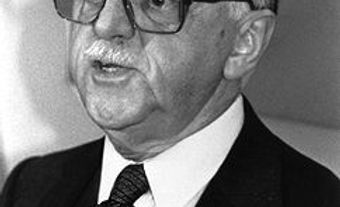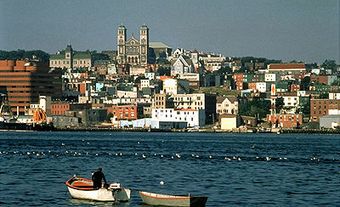"The Maple Leaf For Ever" is a patriotic song composed by Alexander Muir in October 1867, the year of Confederation; both words and music are Muir's. Next to "O Canada," which it antedates by 13 years, it has been the most popular patriotic song composed in Canada. However, because Muir's outlook was purely English-Canadian, his song has not become popular among French Canadians, nor has it remained so even among English Canadians past the middle of the 20th century.
The poem was written as a last-minute entry in the patriotic poetry contest of the Caledonian Society of Montreal and won the second prize. The topic was suggested while Muir and his friend George Leslie were walking in Toronto near Leslie's Gardens (located near Queen St, east of the Don River, and named after the Leslie family of Leslieville, a former suburb of Toronto) and a falling maple leaf lodged on Leslie's coat sleeve, despite efforts to brush it off. "There Muir! There's your text! The maple leaf is the emblem of Canada! Build your poem on that," Leslie is said to have exclaimed. The poem was written and dispatched to Montreal a few hours later. Muir's search for a suitable tune in local music stores proved futile, so he wrote his own.
The original edition (reprinted in The Canadian Musical Heritage/ Le Patrimoine musical canadien vol 3), supposedly of 1000 copies, bears no date and no copyright notice. It was issued probably early in 1868, "published for the author," and printed at the Guardian Office in Toronto, the publishing outlet for the Methodist Book Room. The story that Muir paid $30 to have the song printed and took in less than half that amount is plausible. On the other hand, it is hard to believe Leslie's claim that Muir did not receive "one cent" of royalties from Nordheimer, who brought out the first copyrighted edition in 1871. This edition advertised on its cover that the song was "sung with great applause by J.F. Hardy, esq., in his popular entertainments," thus contradicting another story which purports that the first public performance of "The Maple Leaf For Ever" took place 24 Jul 1874 when Muir directed school children during the laying of the foundation stone of a church in Newmarket, north of Toronto, in the presence of the Earl of Dufferin.
The text of the song was revised by Muir several times. On a copy of the original edition, preserved at the National Library of Canada, Muir's own hand has corrected the first line of the chorus "The Maple Leaf, the Maple Leaf, the Maple Leaf for ever!" to read "The Maple Leaf, our emblem dear, the Maple Leaf for ever!" There were other small revisions and a major one in 1894. On 8 September of that year, the Toronto newspaper The Empire quoted a letter written by Muir in which he complained that incorrect versions of the words of his song had been circulated and went on to give the correct version. This appears to have been a deliberate mystification, for not only do all known pre-1894 versions conform to the original text and its minor adjustments, but the "correct" version really was a new one, having five stanzas instead of four. In fact, the two versions share only two stanzas. The 1894 version, with the awkward opening "In days of yore, the hero Wolfe Britain's glory did maintain," appeared in several publications at the turn of the century, but the original version has remained the popular one: "In days of yore, from Britain's shore, Wolfe the dauntless hero came."
To make good the oversight of the French heritage in Canada, some later editions changed "The thistle, shamrock, rose entwine" to read "The lily, thistle, shamrock, rose" but no French translation of the song has been located. There is however a poem written by Octave Crémazie before 1862 - "Salut, ô ma belle patrie!" - paired with Muir's melody in Choix de chansons (Montreal 1914).
The music almost always is printed in the key of B flat. The tune, which owes something to "My Love Is Like a Red, Red Rose," is cheerful, but its organization is confusing. Verse and chorus begin with the same eight notes, except that the fourth and fifth are at different pitches of the same chord. The sequence G-B flat-F occurs five times, but in four different melodic contexts. It is no wonder that Alexander Cringan, in his school edition, marked five notes with asterisks, warning the teacher that these "are sometimes sung incorrectly."
In 1964 Thompson published "'Our Home, Our Land, Our Canada" - Muir's music with lyrics by Victor Cowley, who had won the Canadian Authors Association Maple Leaf song contest.
Discography
Canadian Armed Forces Tattoo Centennial 1967. Dom LPS 21004
This Is My Country. Mormon Tabernacle Choir. Col MS 6419
See also Roll Back the Years.

 Share on Facebook
Share on Facebook Share on X
Share on X Share by Email
Share by Email Share on Google Classroom
Share on Google Classroom


